When I introduced the first HSF colour challenge (White) I hinted that there would be a second colour challenge this year, and that it would be a little more challenging.
The challenge? Green – from palest spring green through to darkest pine green, and from barely-there eu de nil, to vibrant chartreuse.
White, I think, is easy: almost every historical costumer has a number of white items, just because for most periods white would be the standard colour for most underthings. Green might be a little harder. It has been used in most periods, and while it’s never been the pre-eminent dye, redolent of status and riches, it’s often been a very expensive desirable colour. Green, for all that it is the colour of nature, is actually a very hard dye to achieve with natural dyes, and for most of history it took a double dye bath (first yellow weld, and then an over-dye of indigo or woad (which is indigo, but that’s another story) to achieve green.
Green was complicated to dye, and has an equally complicated symbolism. It’s been the colour of purity and holiness, and the colour of corruption and deceit. The woman in the Arnolfini portrait wears green, and her dress divides art scholars. It’s a pretty obvious clue that the portrait is not, after all, a marriage portrait, but what does it actually mean? Does it symbolise hope? New life? Or a less desirable attribute? Robin Hood & his men wore Lincoln green not to blend in with the forest, but to advertise their loyalty to the area (Lincoln being famous for its green dye), and their success as outlaws: Lincoln green was a reasonably expensive dye (which suddenly makes them seem less like rebels against an unfair ruler and more like Depression Era gangsters in fancy suits).
Whatever green means, it’s certainly not as ubiquitous as white, and it may not be everyone’s favourite colour. As much as I love Flora Poste, she did describe it as “such a trying colour.” Still, I hope many of you will embrace the spirit of the HSF: to be a challenge, and to inspire us to try new things, and use Challenge # 21 as an opportunity to dig in your stash, think outside the box, embrace the colour, and expand your palette.
Or perhaps you already love green!
I love green: it’s probably my favourite colour, and I own oodles of delicious green fabric. Oddly though, the only green item in my historical wardrobe is the Luna Moth frock, and I don’t even like the shade of green. Clearly it’s time for me to add some more green to my personal costuming palette!
Here are a few of my favourite pieces in green to get you thinking about the most verdant of colours:
The aforementioned Arnolfini Portrait. Whatever the gown symbolises, if it does indeed mean anything but that Van Eyke thought a large addition of green would balance the painting, it is certainly gorgeous.
There are many, many 18th century green frocks that make me drool and dream of endless sewing time and fabric budgets, but this one probably takes the cake. Oh, that fabric!
One of green’s associations in English tradition is with the faerie queen and the fey world, which is probably why these green shoes, with their little turned-up elven toes, just seem so right to me.
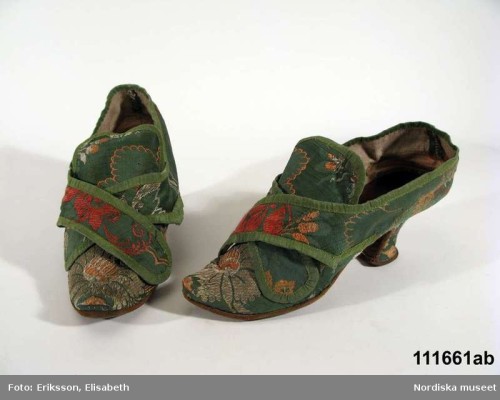
Shoes, 18th century, Nordiska Museet
You know how I hate fringe? Well, as much as I hate fringe, I love bobbles, and this ensemble comes in one of my favourite shades of green, and has bobbles. Love it!
Oh, oh, oh, the next one is just deliciousness! It’s looking a bit mossy in this photo, but the dress is rich emerald green, and everything about it is stunning, and I just can’t imagine another colour it would look half as good in.

Tea gown, 1895, Worth, featured in Paris Haute Couture
I’m sure that when I posted this frock as inspiration for my chinoiserie gown you all swooned. Barely-there is not my favourite style of green, but it is so characteristically Edwardian, that I have to love it for being perfectly of its time!
For those of you afraid of green, not every outfit has to be all green to qualify. This outfit is mostly not green, but the pop of green, so unexpected, is what makes it effective:
I think part of what makes the hunting suit so effective is that the flash of colour is green, not the more expected red, and that it is jade green, not the more expected hunter or forest shades. And jade green? Jade green is just sublime in almost all applications!
One of the periods that really did green, and did it fabulously, was the 1930s. This green striped dress (and matching hat) is just amazing. The way the stripes are turned across the dress, and open up into pleats with the skirt? Gorgeous!
I hope some of these greens got you inspired! For more inspiration, I have an entire pinterest page of green gorgeousness (it goes roughly backwards from the 1930s)
Challenge #21 is due October 21.



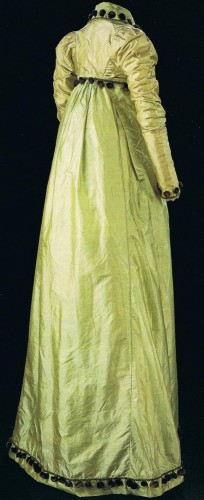
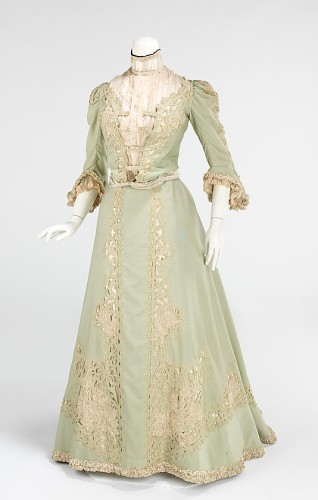
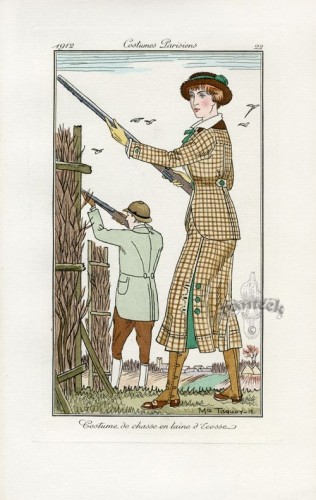
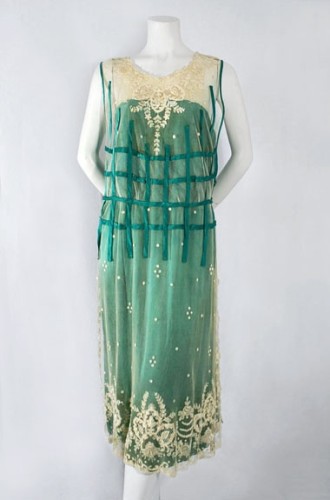
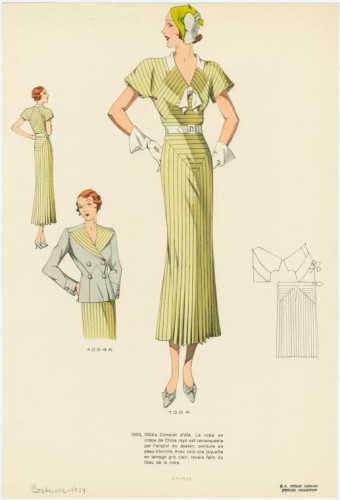
About the Arnolfini portrait, one theory is that it might be a painting from the couple to send to their family in Italy, to show them how good they have it in Bruges (where they lived at the time, if I remember correctly). This also explains the rich winter clothing, while in fact you can see the tree blossoming outside which shows it’s actually spring at the moment. The green and it’s expensive dyes might fit into this theory?
But, it’s just a theory, just like all the others. 🙂 (Though like you pointed out, scholars somewhat agree it’s not a marriage portrait.)
The green doesn’t fit with the ‘showing off the wealth’ theory, as it wasn’t an expensive enough of a dye at the time/place to substantiate it.
We’ll probably never know…
Green and me have a funny history. As a kid, I absolutely, completely, utterly, madly detested green. It was only okay with grass and plants and stuff. I loved blue, on the other hand, and I remember this kid’s brick trolley with red, green, blue and yellow bricks, and I was always ultra careful to keep the blue bricks from touching the evil green bricks by keeping the yellow and red in between.
Now, I LOVE green. Really do. And you know what colour my first ever vintage/antique garment was?
http://i222.photobucket.com/albums/dd23/mabverick/vintage%20clothing/firstitem.jpg
Yep. Gorgeous green.
Wow, that’s a serious aversion to green! I wonder what triggered it! I’m so pleased you got over it though, and your first garment is fantastic! What a divine shade of green! I’d love to hear the story of how you came to pick that piece.
It was the first antique garment I saw for sale that I could afford! (I think it was £15 – and I was 10!). Wish you could see the buttons down the front. They’re silver metal with brown velvet pressed in between them so they have little brown pansies down them. Utterly To Die For.
Re the green aversion – I’ve wondered about this for ages too. Maybe it was because monsters and bad guys were always green and of course, Doctor Who went in for Green Goo…
Oh, you clever thing! I didn’t manage to collect anything real until I was in my ‘teens, and have never lived where pre-mid 20th century clothing was even reasonably common in antique stores. Sigh.
Pansy-patterned buttons! Oh, the Victorians really knew how to do things in some ways…
Funny thing about green – my FIRST ever whole Victorian dress?
http://collections.vam.ac.uk/item/O140293/dress-unknown/
Green! (Very dark bottle green)
My first pre-1850s dress?
http://i222.photobucket.com/albums/dd23/mabverick/vintage%20clothing/1840dress.jpg
Green! (with the most fab ombre roller print pattern that is like nothing else I’ve ever seen… fabric is mid-1840s, but the dress has the sleeves of a late 1830s dress despite being pretty fashionable in all other respects – intriguing!)
And the one thing I still CANNOT believe I lucked onto for a mere £15, even though I had to have a bundle of velvet and silk scraps disentangled and sewn back together by a lady who did restoration for the National Trust?
http://s222.photobucket.com/user/mabverick/media/vintage%20clothing/1820pelisse.jpg.html?sort=3&o=76
Olive-green silk velvet with dingle-dangle military tassels, silk-covered buttons and straps, double-sleeves – and an unseen apple-green silk lining! Green, green!
So it’s lucky I got over the green aversion isn’t it? 😉
Oops. First link should’ve gone to http://i222.photobucket.com/albums/dd23/mabverick/vintage%20clothing/1880goldgreen1.jpg
I love…some greens. Unfortunately, I think the commonest greens that one sees in American fabric shops nowadays are ugly, drab colors with too much blue in them, or that are contaminated with brown.
The Byzantine overtunic I’m working on now is a lovely apple green. You can see a picture of the fabric on my blog here: http://cathyscostumeblog.blogspot.com/2013/07/sewing-for-byzantium-starting-himation.html
Maybe I can manage to get enough of this one done in time for HSF #21. We’ll see!
Greens definitely goes in and out of fashion. I’m seeing a lot of eu de nil and muted mint in NZ, and on the other end of the spectrum, bright jade and GREEN green, both far too literal and vivid for my taste. Makes me glad of the stash, so at least I know I’ll have pretty greens to work with!
I do like apple, and the combination in your himation is gorgeous! You’ve got over three months – I hope you can finish it!
Happy day! Your dedicated watcher is actually making something that might be said to fit one of your challenges. I am knitting fingerless mittens in possum-merino in a very pleasing shade of green. The prototypes are for me, but maybe next winter…
Oh, if only I had the right fabric! Which I won’t have in time, I’m afraid… The right fabric(s) for a green redingote with red lapels, like this one:
http://dressedintime.blogspot.cz/2011/11/redingotes-and-riding-habits.html
– which was a very popular fashion with Prague ladies at the end of the 18th century, the book on Czech fashion in 1780-1870 by Eva Uchalová tells me.
Mine would have to be a transitional 1790s redingote, though, if such a thing existed, because I don’t want to wenture into the conical shape era. Especially seeing as I would probably want to wear it in everyday settings to get the most wear out of it.
There are some metal buttons with the Prague coat-of-arms in the stash that I paired up with it in my mind – cut off from a tram conductor’s uniform, father tells me, but that does not interfere with the purpose. What intereferes with my personality more is that I do not feel any particular connection to Prague… but I still love the whole idea.
*sigh*
(Alternately, I’ll just finally make my sari dress, but I would like to make that one earlier than this challenge!)
Isn’t it interesting where you find your ‘spiritual home’? I knew so many people when I lived in Hawaii that felt grounded, at peace, and instantly–deeply–happy there. In contrast, I did not feel that way. But the very second I stepped off of the plane in Germany, I knew exactly what those people meant. It was like the air brought health and vibrancy and art and everything good.
Where is your spiritual home if not Prague? Oh! Do you make clothes with its provenance? How wonderful!
Oh yes. Bohemian-Moravian Highlands, hands down. Just going through the Highlands by train refreshes my soul instantly, and places all across it feel like home (actually, most of the Czech places I wrote about on my blog lie at the outskirts of the area…). It is, as father says, “the place where the world looks like what it should look like”.
My family’s roots on one side go to Moravian Wallachia, which is another area that I like a lot, and I also love its folk costume.
In reality, Brno where I study; but I live in a small town near Prague. Brno is much nicer than Prague in certain respects. The centre is much smaller, so you can really walk everywhere. And it’s just more laid back, somehow. Prague is a career city where you rush everywhere, Brno is a student city where you can take your time.
Plus I felt really all right in the Baltic countries; those are the places where I can go abroad and still “remain myself”.
Clothes with provenance are still more of a plan and idea than reality, but yeah. I like to keep being myself even when I go back in time, and anchoring the clothes in some sort of… idea… helps. The dress-up factor only comes second, because even when I dressed up as a child, it was not really pretty pretty princesses, but rather things I felt I “was” – like a red panda. 😀
Cool description. Like you, I prefer smaller places. And I read that the only surviving pieces of primaeval forest exist in the Czech republic.
Can’t wait to read your book of folktales!
Better late than never: I don’t know if it’s the only place, but there’s definitely the BoubÃn Forest – that’s elsewhere, though, and I’ve never been there.
Green green green! I love love green! Even while typically biased towards colors that personally suit me, I love all greens because each beautiful flatters somebody.
I take that back: I really hate the sickly yellow-green of trees in the US Midwest.
I cannot wait to see what everyone comes up with! And how interesting that you have to gather greens when you can since shades will only flash into fashion then out!
Green is my favorite color…..and i love love love the Worth dress. I had seen it before and if I ever find fabric like that I will definitely make it.
Ohhhhh, I am giddy with excitement about this challenge! Green is my absolute favorite color, and I have a garment in mind that I’ve been wanting to make for a couple of years now. Perfect!
Oooh, I love green! Well, most shades of green. I don’t like neon green or barf green, but all the other greens are gorgeous!
your page of inspiration pictures is overwhelmingly fabulous. I think almost every green historical garment I have ever seen is there.
3 months will be enough time to finally finish these pockets! They have enough green in them, don’t they?
http://mouseborgdesigns.blogspot.ca/2013/01/embroidered-strawberry-pockets.html
Oh, the dress with bobbles – http://collections.vam.ac.uk/item/O140293/dress-unknown/
Oh you are fantastic! Thank you! (now off to update this on my website, and pinterest). And it is a dress with a matching spencer!
You know EVERYTHING!
Vogue Pattern magazine (Aug/Sep ’13) just came out with an article on green through history – and the same Van Eyck (sp?) reference. Must be a sign for me to get on the ball with this one 🙂
Oh! I have some green silk I was going to make a Venetian out of and some lovely green trim I was going to use for the faux partlet. This will be fun. 🙂
[…] thought about making this for the Historical Sew Fortnightly # 21: Colour Challenge Green, but it took me too long to commit to the K&C wool, and at that price, you can bet I’ll […]
[WORDPRESS HASHCASH] The comment’s server IP (66.155.38.58) doesn’t match the comment’s URL host IP (76.74.254.123) and so is spam.
[…] It’s been on my sewing list for a few months to add a bit more trim to the sleeves of Evie, my most recent Civil War era dress, but I’ve been working on knitting my sweater and completing other projects, like my 1822 Walking Dress, so I hadn’t really been inspired to complete the trim. However, the Commonwealth Vintage Dancers were asked to run a ball as part of recent Civil War reenactments in Worcester, MA, and that gave me the perfect incentive to finish up trimming Evie! She also happens to be green, so this is my entry for the HSF Challenge #21: Green. […]
[WORDPRESS HASHCASH] The comment’s server IP (192.0.80.55) doesn’t match the comment’s URL host IP (66.155.9.238) and so is spam.
I’ve just posted about my completion of this challenge at http://quinnmburgess.wordpress.com/2013/10/16/hsf-21-trim-for-evie-in-time-for-a-ball/
Best,
Quinn
[…] and the What Cheer Day sewing, while totally gratifying, happened when I was thinking about the “Green” color challenge. But, on the positive side, because I’ve waited and played with Spencers, I have a much better […]
[WORDPRESS HASHCASH] The comment’s server IP (66.155.8.79) doesn’t match the comment’s URL host IP (66.155.11.238) and so is spam.